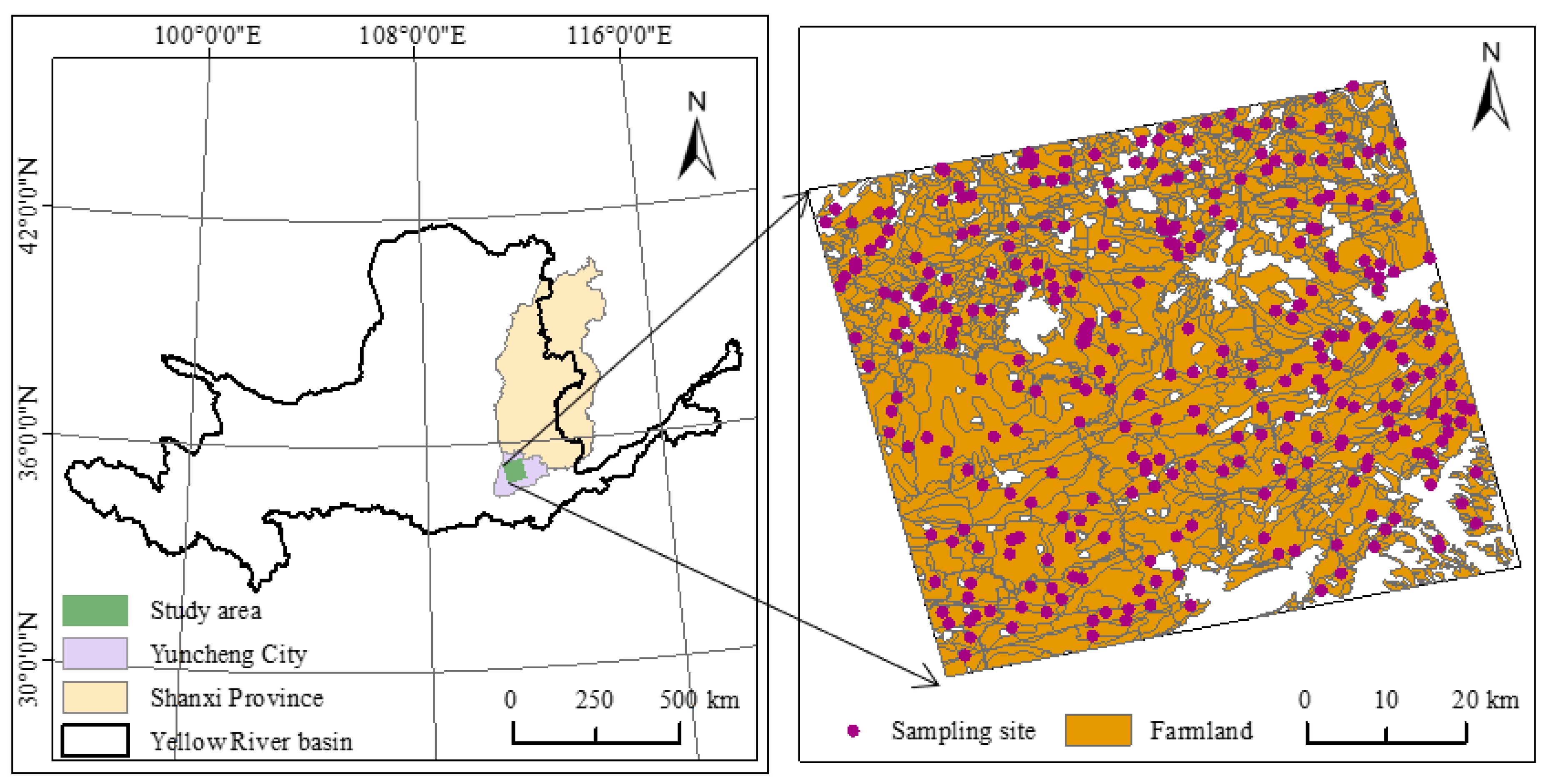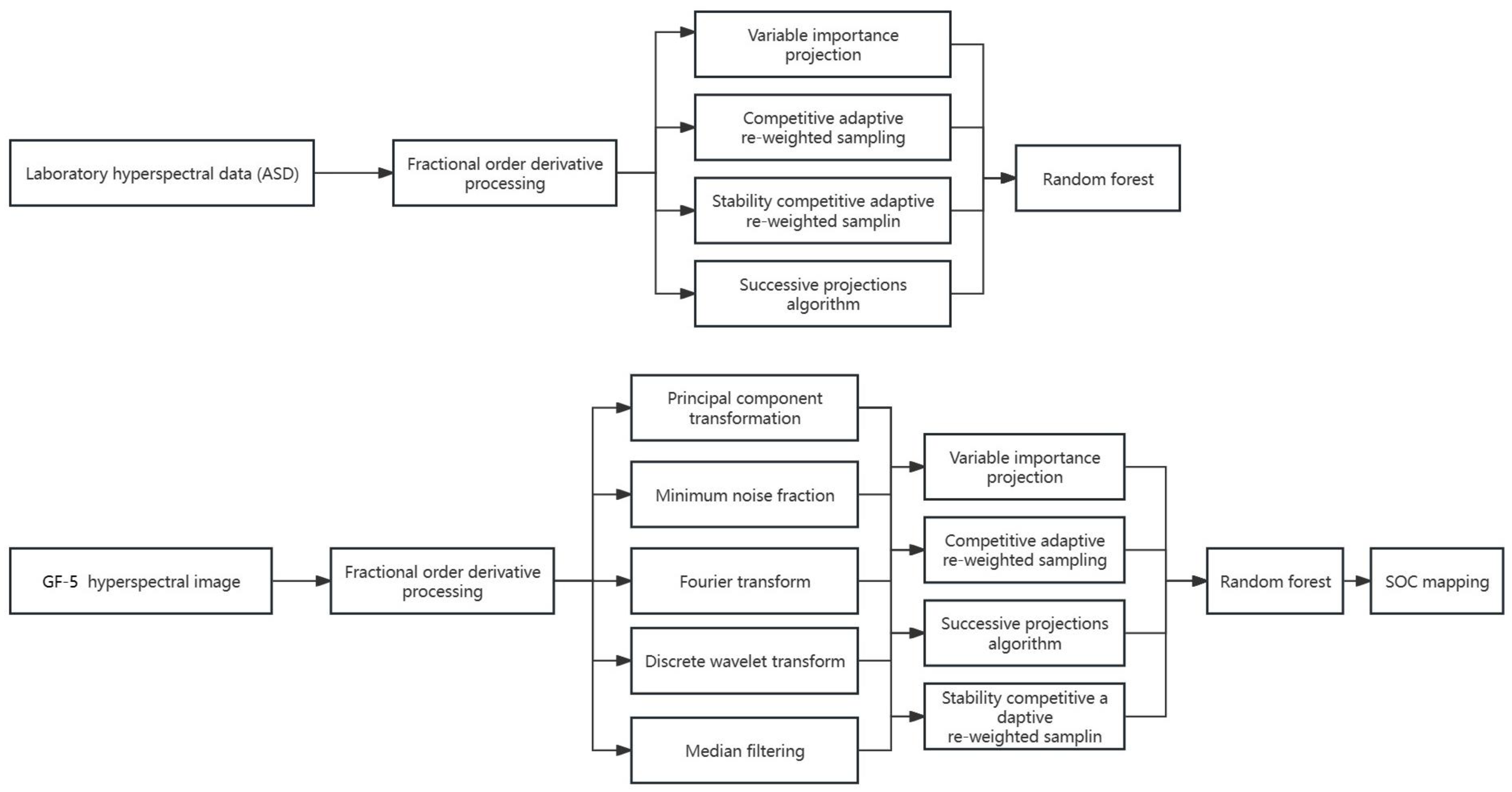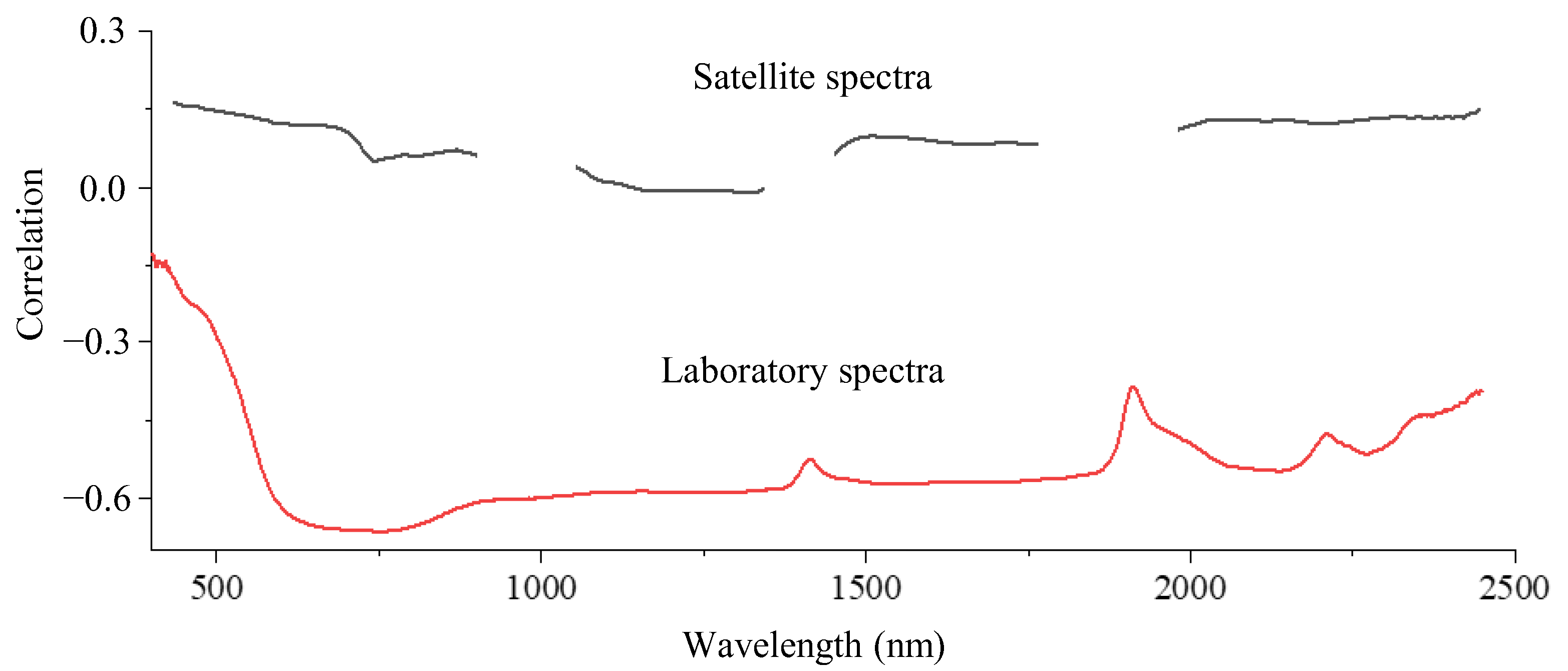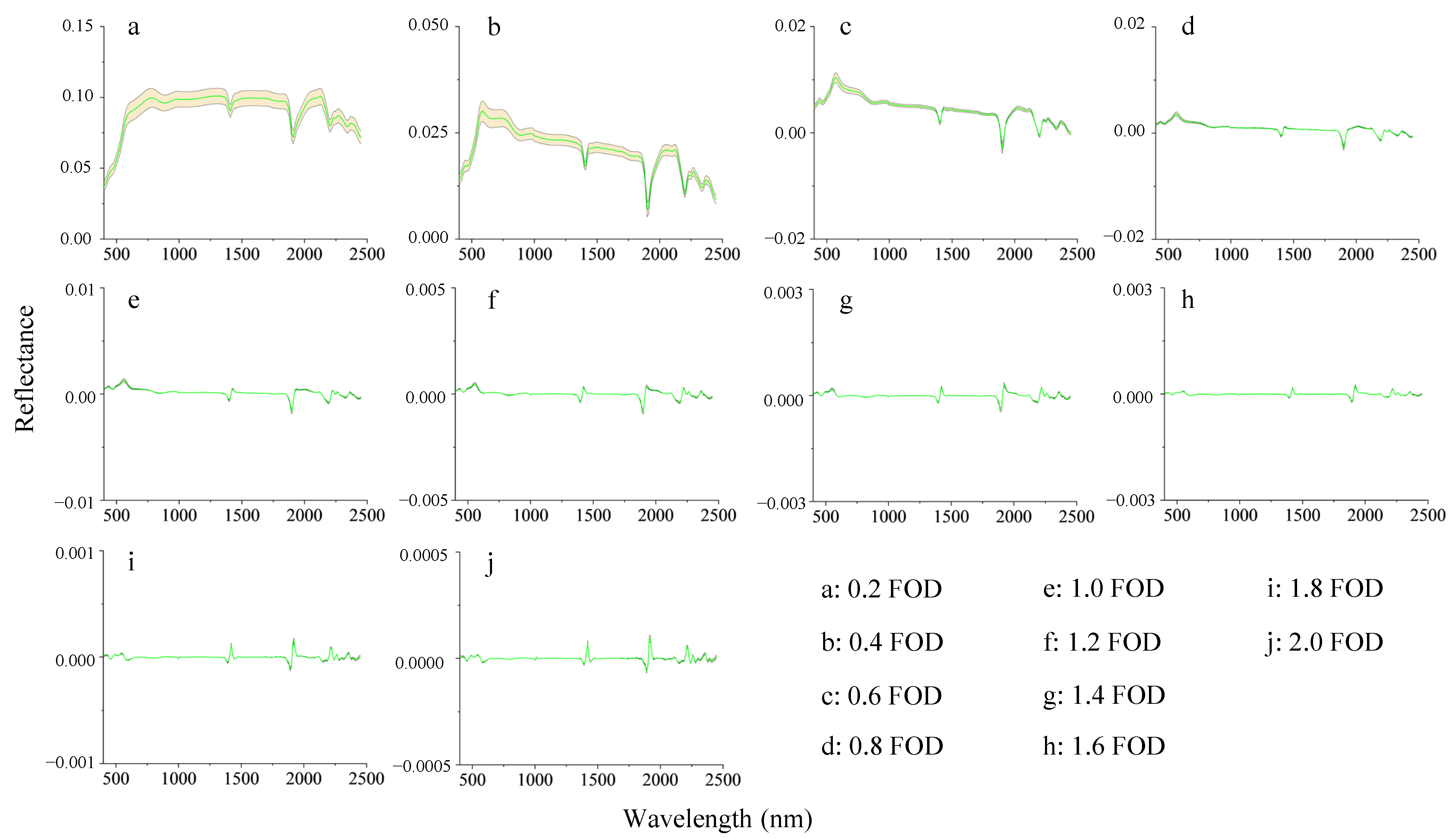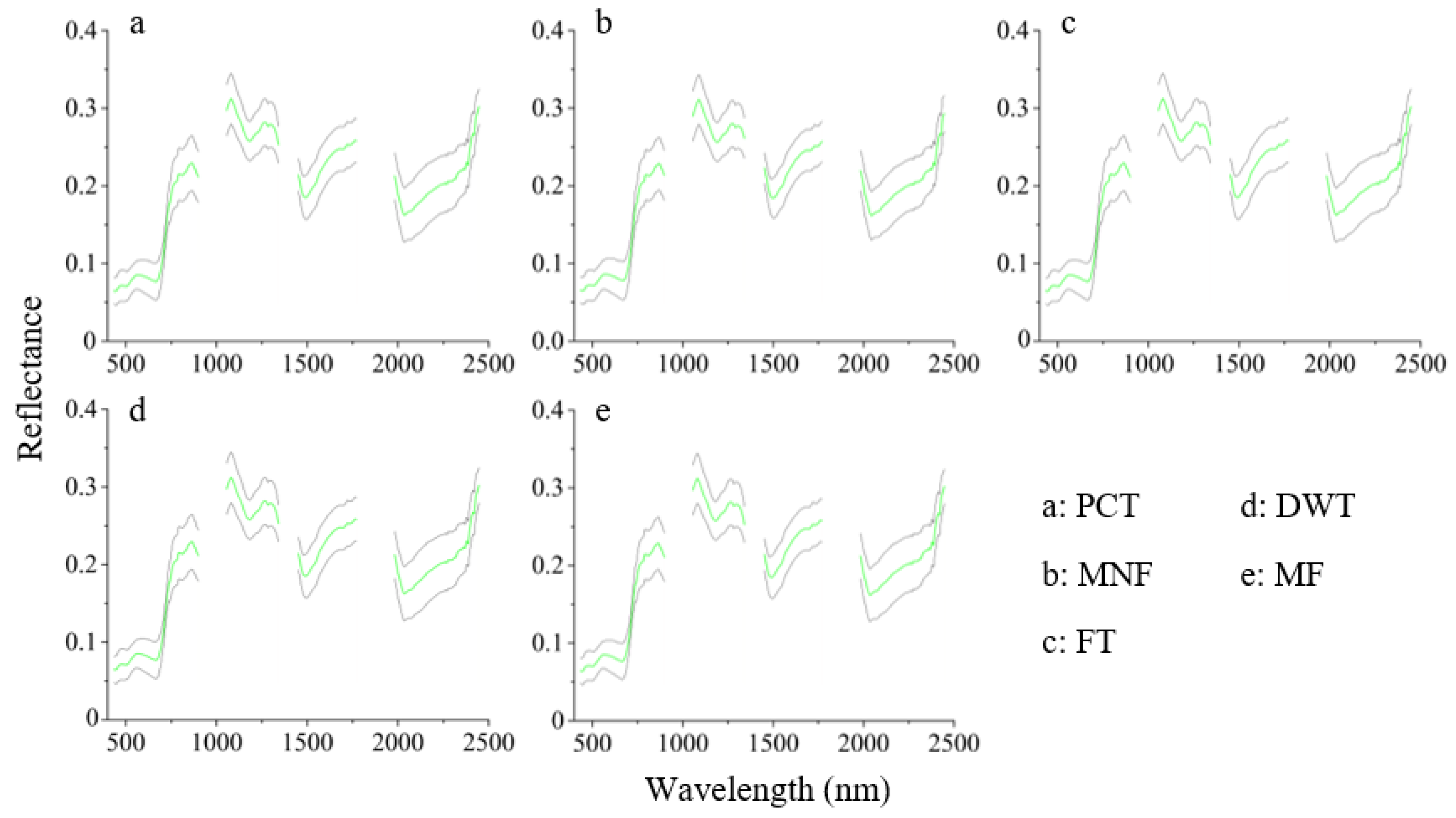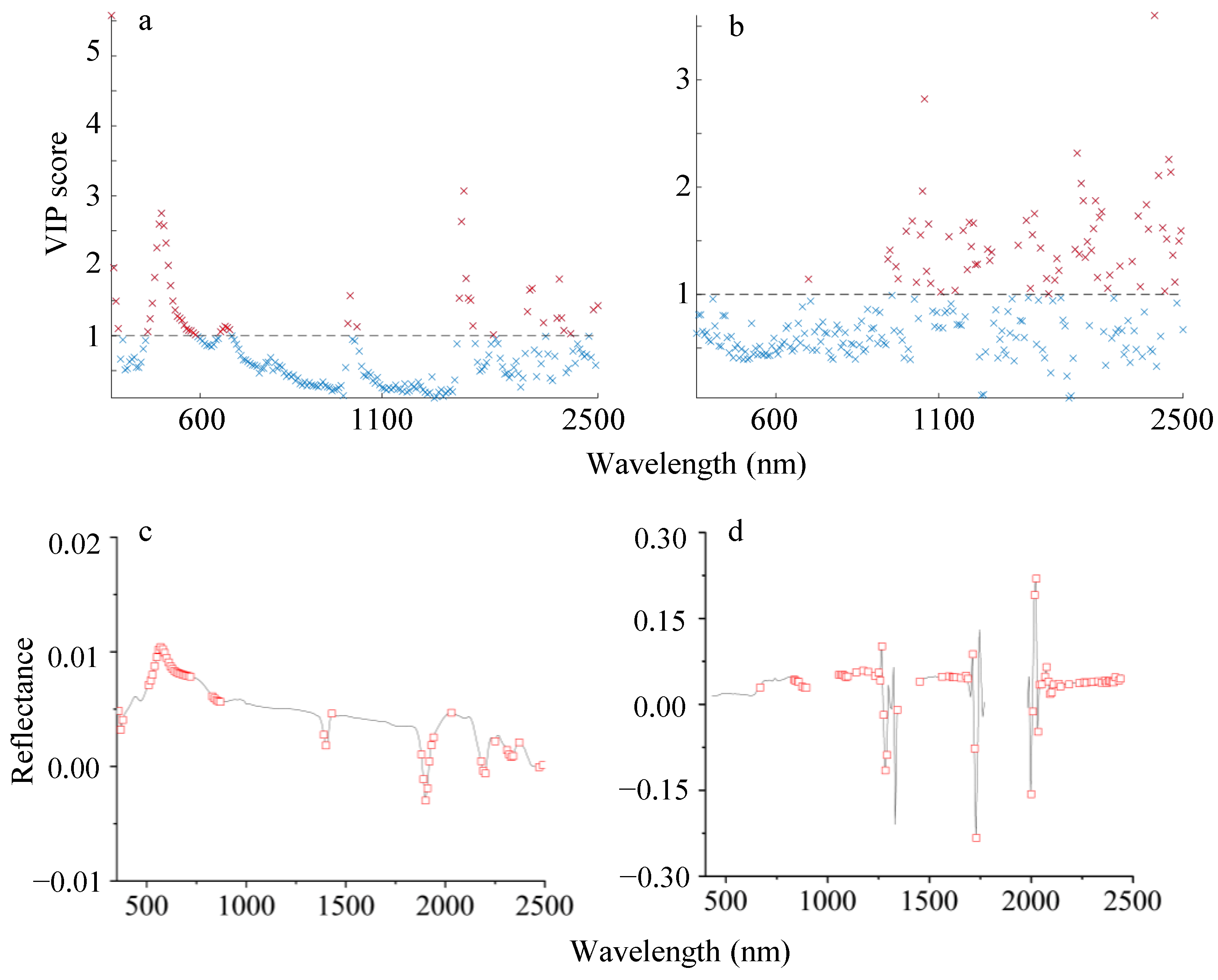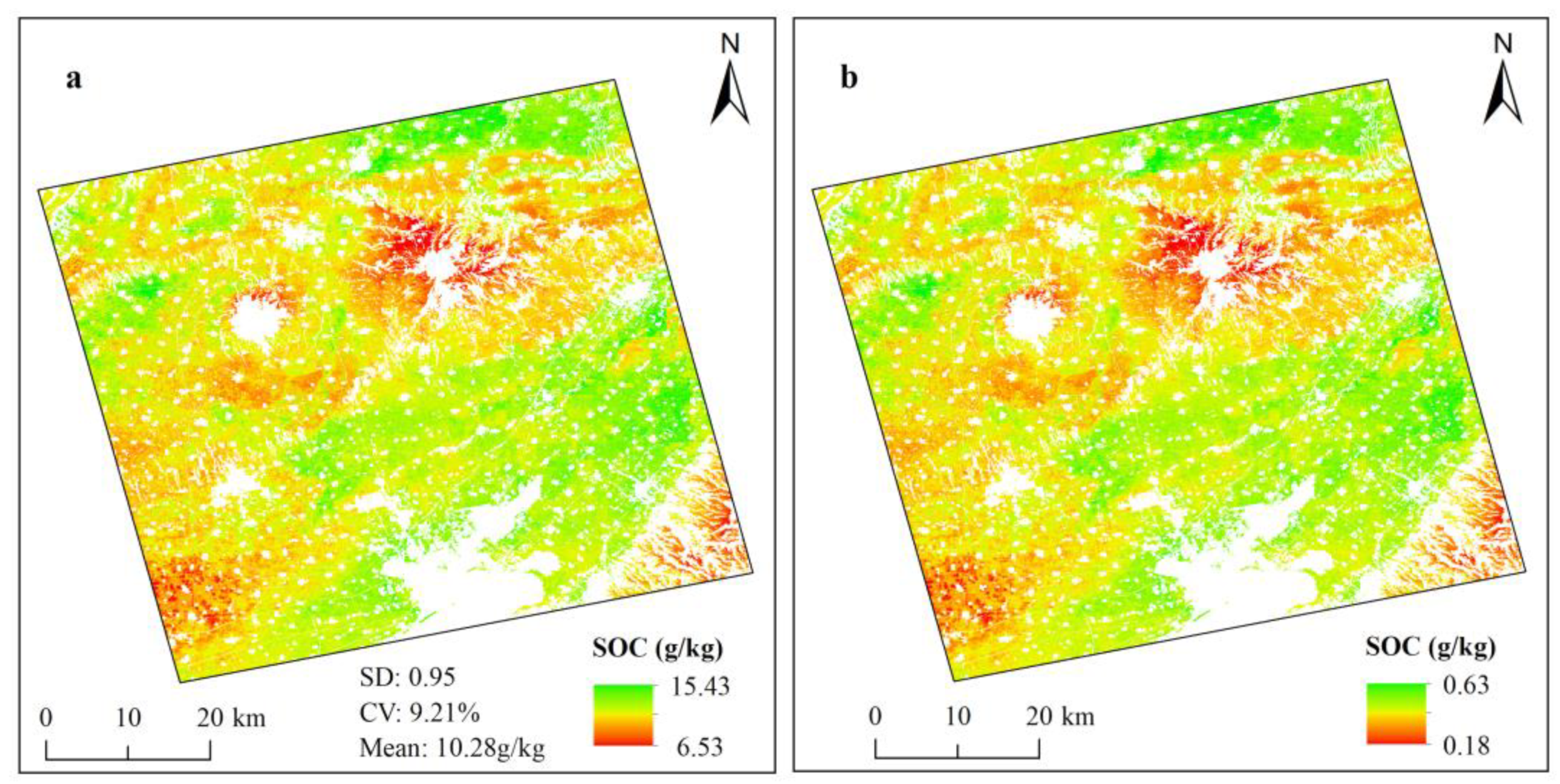3.2. Spectral Characteristics
In general, the measured SOC values in the laboratory and GF-5 satellite hyperspectral curves exhibit similar spectral shapes, but there are also some differences (
Figure 5). The difference in reflectance between laboratory hyperspectral and GF-5 satellite hyperspectral is mainly due to the presence of crop residues in the soil caused by the return of crop straw. Despite the SG smoothing applied to the satellite hyperspectral reflectance curves in this study, the laboratory spectral curves remained smoother than the satellite hyperspectral curves, with a smaller standard deviation. This suggests that the satellite hyperspectral data were influenced by varying degrees of noise interference. For both laboratory and satellite hyperspectral data, reflectance increased rapidly with wavelength in the 400–1000 nm range, attributed to the presence of iron ions and organic matter. However, certain differences in reflectance at various wavelengths, particularly after 2000 nm, indicated spectral distinctions under different measurement conditions, potentially affecting the accuracy of SOC prediction. The difference in reflectance between laboratory hyperspectral and GF-5 satellite hyperspectral is mainly due to the presence of crop residues in the soil caused by the return of crop straw.
To analyze the relationship between laboratory and satellite hyperspectral spectra with SOC, the study conducted a Pearson correlation analysis between the measured SOC values and every band of laboratory and GF-5 satellite hyperspectral data (
Figure 6). Results indicated that the absolute values of the correlation coefficients between measured SOC values and laboratory spectra (0.11–0.67) were much higher than those of satellite hyperspectral data (0–0.19), suggesting that the external environmental interference experienced by GF-5 satellite hyperspectral data significantly masked the relationship between SOC content and the spectral reflectance itself. Compared to laboratory hyperspectral data, satellite hyperspectral data without denoising may struggle to predict SOC content accurately.
3.3. FOD Processing of Laboratory Hyperspectral Data
Soil hyperspectral data exhibit comprehensive spectral characteristics reflecting various soil physicochemical components, and absorption peaks of these components may interfere with each other to varying extents. Spectral derivative technology not only separates absorption peaks but also amplifies weak absorption peaks. As depicted in
Figure 7, a comparison of 0–2.0 order (with intervals of 0.2 order, totaling 10 orders) derivative transformations revealed that the spectral reflectance values of laboratory spectra gradually decreased from 0 order to 0.6 order, with absorption bands narrowing and no significant distortion of absorption peaks (
Figure 7a–c). In the 0.8–2.0 order derivatives, spectral reflectance curves gradually stabilized, reflectance values continued to decrease, and absorption bands continued to narrow, with the original shape of the spectrum gradually disappearing (
Figure 7d–j). Although correlating spectral absorption peaks with specific components in the soil is a challenging task, FOD processing aids in extracting sensitive information.
To select the optimal order of fractional derivative for predicting SOC with laboratory hyperspectral data, this study constructed SOC prediction models using the RF model with both the original and various FOD processed spectral reflectance as independent variables, evaluating their capability in predicting SOC. The accuracy evaluation results are shown in
Table 3. The results indicated that models processed with FODs had stronger predictive abilities than the original spectra. Under different FODs, the inversion accuracy of SOC (R
2) ranged between 0.49–0.84, with RMSE decreasing from 1.73 to 1.28, and MAE values from 0.71 to 0.48. Compared to the original hyperspectral model, the predictive abilities of the models after 0.6, 0.8, and 1.6 order derivative processing were the strongest, with the 0.6 order derivative processed model having the highest accuracy (R
2 = 0.84, RMSE = 1.28, MAE = 0.48). Therefore, the 0.6 order derivative is the optimal order for processing laboratory hyperspectral data.
3.4. Image Denoising of GF-5
To reduce noise in satellite hyperspectral imagery, various denoising methods were applied to GF-5 hyperspectral images.
Figure 8 and
Figure 9 show satellite images and hyperspectral reflectance curves of GF-5 images after different denoising processes, respectively. After various denoising treatments, slight differences in color, brightness, and texture were observed in different features of the satellite images. Compared to the original satellite hyperspectral image, the denoised spectral curves were smoother, indicating that denoising could eliminate some noise from the satellite images. However, it was difficult to visually determine the best denoising method among the different approaches.
Therefore, using the hyperspectral reflectance after different denoising treatments as the independent variable and SOC as the dependent variable, SOC prediction models were constructed using the RF method to determine the optimal denoising method (
Table 4). The results showed that the SOC prediction accuracy decreased after median filtering compared to the original GF-5 image (
Table 4), likely due to the averaging method of pixel spectral denoising in MF. Similarly, after PCT of GF-5 images, the accuracy of SOC prediction also decreased (
Table 4), possibly related to the mechanism of PCT. PCT outputs new principal component bands from hyperspectral image bands (equal to the number of input spectral bands), with the first principal component containing the largest percentage of data variance, followed by the second, and so on. The last principal component bands, containing very small variances (mostly from original spectral noise), also include some image information. Moreover, GF-5 satellite hyperspectral images after MNF showed slightly stronger SOC prediction ability than the original image (
Table 4). Notably, DWT and FT significantly enhanced the ability of GF-5 satellite hyperspectral images to predict SOC (
Table 4). The best satellite image denoising method in this study was wavelet transformation, which, after application, showed the highest increase in SOC prediction accuracy (R
2 = 0.48, RMSE = 1.78, MAE = 0.71).
3.5. Optimal FOD Processing for Various Denoised Images
As demonstrated previously (
Section 3.3), FODs applied to laboratory hyperspectral data significantly enhance the accuracy of SOC prediction. In order to improve the predictive capacity of satellite hyperspectral data for SOC, this study identified the FOD order that yielded the highest prediction accuracy for SOC (
Table 5) and applied it to process GF-5 images. The results indicated that after subjecting GF-5 satellite hyperspectral images to different FOD treatments, the SOC prediction accuracy (R
2) increased from 0.31 to 0.52, RMSE decreased from 2.04 to 1.68, and MAE values decreased from 0.98 to 0.76. In comparison to the original hyperspectral model, the model processed with the 0.8 order derivative exhibited the most substantial improvement in predictive ability (R
2 = 0.52, RMSE = 1.68, MAE = 0.76). Therefore, the optimal order for processing satellite hyperspectral data is 0.8, which differs from the optimal order for processing laboratory hyperspectral data. This discrepancy could be attributed to variations in noise characteristics between laboratory and satellite hyperspectral data. It is noteworthy that, for both laboratory and satellite hyperspectral data, FOD processing demonstrated a more pronounced impact than integer order derivative processing, highlighting the superior ability of FODs to capture subtle changes in the spectrum.
Since the 0.8 order derivative processing proved to be the optimal method for predicting SOC in GF-5 satellite hyperspectral imagery, the study further denoised the 0.8 order derivative processed GF-5 satellite images and explored SOC prediction modeling using the RF model.
Table 6 presents the modeling results, indicating that after PCT and median filtering denoising of the 0.8 order derivative processed images, the model accuracy was still lower than that of 0.8FOD-R, while 0.8FOD-MNF exhibited similar accuracy (R
2 = 0.52). The SOC prediction accuracy of 0.8FOD-DWT and 0.8FOD-FT significantly increased, with 0.8FOD-DWT achieving the highest accuracy (R
2 = 0.61, RMSE = 1.78, MAE = 0.71).
Figure 10 depicts a satellite image of a local area of the GF-5 imagery after optimal noise reduction processing (0.8FOD-DWT) and its spectral reflectance chart. The 0.8FOD-DWT amplifies parts of the spectral curve, making the curve changes clearer and facilitating the distinction of differences in SOC content.
3.6. Spectral Feature Selection
As previously mentioned, with the full bandwidth as the dependent variable for SOC modeling, the 0.6FOD was the best model for laboratory hyperspectral SOC prediction, and 0.8FOD-DWT denoised GF-5 imagery was the best for satellite hyperspectral SOC prediction. Indeed, hyperspectral data have some bands unrelated to SOC, with high overlap or collinearity between bands. Through spectral band variable extraction techniques, spectral data dimensionality can be reduced, enhancing the robustness and accuracy of the SOC hyperspectral inversion model. This study used four methods, VIP, CARS, sCARS, and SPA, to select spectral wavelength variables with the strongest explanatory power for SOC.
Figure 11 shows the feature band results selected by the VIP method for 0.6FOD processed laboratory hyperspectral and 0.8FOD-DWT denoised GF-5 satellite hyperspectral data. The higher the VIP score, the more significant the feature importance of the related band. To determine the optimal number of feature bands, the study set a threshold of 1.0 (
Figure 11a,b). When VIP > 1.0 (above the blue dotted line), SOC feature bands of laboratory spectra were mainly located near 500 nm and in some bands between 1800–2450 nm, with the red box in
Figure 11c indicating the selected feature bands, totaling 53, approximately 24.65% of the full bandwidth (
Figure 11c). In contrast, SOC feature bands of satellite hyperspectral data were mainly after 1100 nm, totaling 70, approximately 29.17% of the full bandwidth (
Figure 11d).
The CARS algorithm was employed to select feature bands from 0.6FOD laboratory hyperspectral data and 0.8FOD-DWT denoised GF-5 satellite hyperspectral data, as illustrated in
Figure 12. The results demonstrated a gradual decrease in the number of retained wavelength variables as the number of iterations increased. The RMSECV initially decreased and then increased with the rising number of iterations (
Figure 12a,b). For the 0.6FOD laboratory hyperspectral data, the minimum RMSECV value was obtained at the 17th iteration, and beyond this point, bands related to SOC may have been excluded, resulting in an increase in RMSECV value. At this stage, the optimal bands for predicting SOC were 18, accounting for approximately 8.37% of the total bands (
Figure 12c). For the 0.8FOD-DWT satellite hyperspectral data, the minimum RMSECV value was observed at the 22nd iteration, with the best SOC prediction bands being 8, representing about 3.33% of the total bands (
Figure 12b,d). Similarly, the sCARS algorithm was also applied (
Figure 13), showing that the minimum RMSECV values for the 0.6 FOD laboratory hyperspectral data and the 0.8FOD-DWT satellite hyperspectral data were achieved at the 33rd and 25th iterations, respectively. At these points, eight and seven bands were selected as the optimal number of bands for SOC prediction, for the laboratory and satellite data, respectively (
Figure 13c,d). It is noteworthy that the number of bands selected by sCARS was fewer, likely due to the algorithm’s emphasis on the stability of variables.
After processing the laboratory and GF-5 satellite hyperspectral data with 0.6FOD and 0.8FOD-DWT, respectively, the SPA algorithm was employed to extract feature bands. The determination of the number of feature bands was based on calculating the minimum RMSE values for different band combinations. The SPA algorithm results, as shown in
Figure 14, indicate a significant decrease in RMSE for both laboratory and satellite hyperspectral data when the number of feature bands ranges from 1 to 21 and 1 to 5, respectively. After that, the trend gradually levels off. Specifically, for the 0.6FOD laboratory spectrum, 15 feature bands were selected (indicated by the black box in
Figure 14c). Although the RMSE was smallest at 21 bands, the relationship between these bands and the measured SOC was not significant. In contrast, at 15 bands, the relationship was significant. These 15 bands represent about 6.98% of the total bands. For the satellite hyperspectral data, five feature bands were selected, accounting for approximately 2.08% of the total bands (
Figure 14d).
3.7. SOC Prediction
In this study, feature bands selected using the VIP, CARS, sCARS, and SPA algorithms were employed as independent variables, with SOC as the dependent variable, to construct eight RF models. These include 0.6FOD-VIP, 0.6FOD-CARS, 0.6FOD-sCARS, and 0.6FOD-SPA based on laboratory hyperspectral data, and 0.8FOD-DWT-VIP, 0.8FOD-DWT-CARS, 0.8FOD-DWT-sCARS, and 0.8FOD-DWT-SPA based on GF-5 satellite hyperspectral data. These models were compared with full-bandwidth RF models. As per the results in
Table 7, the accuracy of the models with feature band selection was found to be higher than those using full-bandwidth models for both laboratory and satellite hyperspectral data. The ranking of feature band selection techniques in terms of effectiveness was sCARS > CARS > SPA > VIP. Notably, feature band selection techniques effectively eliminate redundant variables in hyperspectral bands, reduce collinearity between adjacent bands, and extract important feature information variables related to SOC. This reduction in the number of variables involved in modeling decreases the complexity of the models while maximizing their prediction accuracy. Furthermore, the feature bands selected by the sCARS algorithm performed better in predicting SOC. The R
2 values of 0.6 FOD-sCARS for laboratory hyperspectral and 0.8 FOD-DWT-sCARS for satellite hyperspectral models were significantly higher than those of the full-bandwidth models, with noticeably lower RMSE and MAE.
3.8. SOC Mapping and Uncertainty Analysis
Using the RF model established with feature bands selected by the 0.8FOD-DWT-sCARS algorithm for satellite hyperspectral data, the spatial distribution of surface SOC in the study area and its associated prediction uncertainty were mapped (
Figure 15). The predicted SOC values closely aligned with the actual measurements, averaging around 10.28 g/kg. The range, CV, and standard deviation of the predicted values were notably lower than those of the measured values (
Figure 15a). These findings align with previous studies on SOC prediction [
36], indicating a relatively stable model in terms of simulation accuracy and its ability to capture spatial heterogeneity.
The SOC spatial distribution map reveals that areas with low SOC are primarily located in high-altitude mountains, characterized by sloped, fragmented cultivated land of relatively low quality, resulting in poorer soil. Additionally, SOC generally exhibits a higher concentration in the east and lower levels in the west, potentially due to the western part’s proximity to the Yellow River, leading to relatively sandy soil. Furthermore, the results indicate that the spatial uncertainty of SOC prediction mirrors the distribution of SOC, with areas exhibiting higher SOC uncertainty also demonstrating higher content. Overall, the standard deviation of the SOC map is relatively small, ranging between 0.18–0.68 g/kg, indicating the model’s robust performance in predicting SOC.
